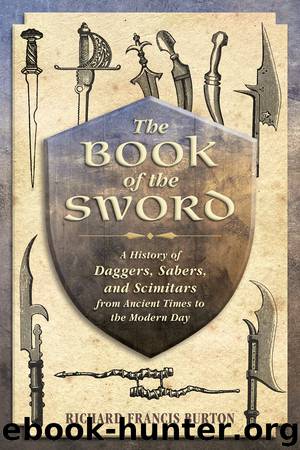The Book of the Sword by Richard Francis Burton

Author:Richard Francis Burton [Burton, Richard Francis]
Language: eng
Format: epub
ISBN: 9781628738476
Publisher: Skyhorse Publishing (Perseus)
Published: 2013-12-26T07:00:00+00:00
FIG. 203.—ASSYRIAN LANCE WITH COUNTER-WEIGHT.
FIG. 204.—ASSYRIAN SPEAR-HEAD.
FIG. 205.—ASSYRIAN ‘RAZOR.’
A sickle-shaped tool from a bas-relief. A similar weapon in iron, found at Paestum in Lucania, is preserved in the Musée d’Artillerie at Paris.
In mimic war (hunting) the Assyrians were proficients. Many hundreds of bas-reliefs, which are more natural because less conventional than those of Egypt, illustrate the chase of the lion, stag, and jungle-swine; the wild horse, ass, and bull. They were equally skilled in the art of war, which is shown in all its phases, the march, the passage of streams, the siege, the battle, the sea-fight, or rather the river-fight, the pursuit, and the punishment of prisoners by torturing, impaling, flaying alive, crucifixion, and ‘tree-planting’ or vivi-interment. The abominable cruelties of these Asiatics, still practised by the Persian, the Kurd, and the ‘unspeakable’ Turk, contrast strongly with the mildness of the African Egyptians. Their walls, single or double, were provided with the fosse and the rampart, and with machicolations, crenelles, and battlements; the last two originally shields like the Egyptian cartouche. The places fortes were attacked by the wheeled tower,2 the iron-pointed battering ram, the scaling ladder, and the pavoise, or large shield common throughout Europe in the fifteenth and sixteenth centuries.3 In the field pennons are attached to the lances, and the standard-bearers carry eagles. The action begins with missiles, slings, darts, and arrows; the mace and spear then play their part, and the Sword is never absent. The warriors—who appear on foot or horseback, with gorgeous caparisons, in chariots or swimming with floats of inflated skins-wear helmets of many shapes, crested, crescented, capped with the fleur-de-lys and perfectly plain; some are close-fitting with ear-flaps, the common skull-cap (namms) of Ancient Egypt, and the Indian Kan-top. The head-gear usually ended in a metal point—the pickelhaube. The sculptors show imbricated armour or hauberks (mail-coats) of the Norman type, with stockings of iron-(?) rings, gaiters, and boots laced up in front. The shields, either circular or rounded at the top and straight at the bottom, cover the whole body.
Download
This site does not store any files on its server. We only index and link to content provided by other sites. Please contact the content providers to delete copyright contents if any and email us, we'll remove relevant links or contents immediately.
| Africa | Americas |
| Arctic & Antarctica | Asia |
| Australia & Oceania | Europe |
| Middle East | Russia |
| United States | World |
| Ancient Civilizations | Military |
| Historical Study & Educational Resources |
Cecilia; Or, Memoirs of an Heiress — Volume 1 by Fanny Burney(32041)
Cecilia; Or, Memoirs of an Heiress — Volume 3 by Fanny Burney(31446)
Cecilia; Or, Memoirs of an Heiress — Volume 2 by Fanny Burney(31395)
The Secret History by Donna Tartt(18123)
Sapiens: A Brief History of Humankind by Yuval Noah Harari(13964)
Leonardo da Vinci by Walter Isaacson(12781)
The Radium Girls by Kate Moore(11603)
Sapiens by Yuval Noah Harari(5113)
How Democracies Die by Steven Levitsky & Daniel Ziblatt(4948)
The Wind in My Hair by Masih Alinejad(4831)
Homo Deus: A Brief History of Tomorrow by Yuval Noah Harari(4681)
Endurance: Shackleton's Incredible Voyage by Alfred Lansing(4488)
The Silk Roads by Peter Frankopan(4262)
Man's Search for Meaning by Viktor Frankl(4254)
Millionaire: The Philanderer, Gambler, and Duelist Who Invented Modern Finance by Janet Gleeson(4078)
The Rape of Nanking by Iris Chang(4015)
Hitler in Los Angeles by Steven J. Ross(3794)
Joan of Arc by Mary Gordon(3776)
The Motorcycle Diaries by Ernesto Che Guevara(3774)
